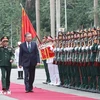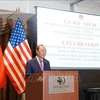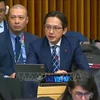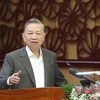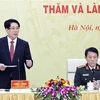The number of women in leadership positions in political organisations, including the National Assembly and Government, has yet to reach its full potential, said Deputy Head of the Vietnam Women’s Union Nguyen Thi Thu Ha.
Speaking at a policy dialogue on promoting women’s participation in politics on March 26, Ha said improper regulations and gender discrimination were huge impediments for women who wanted to get involved in politics.
According to the union’s 2011 statistics, women filled over 8 percent of posts in party committees at the central level, 11 percent at the provincial level, 15 percent at the district level and 18 percent at the commune level.
Vice Director of Centre for Education Promotion and Empowerment of Women (CEPEW) Ngo Thu Ha said the number of women in leadership posts has barely increased and even decreased.
In the National Assembly (NA), for example, the percentage of female deputies declined in the last decade, from 27.3 percent in the 11 th NA (2002-07) to 24.2 percent in the 13 th NA (2011-16).
She said few women have real power in decision making and few take key positions, blaming the problem on regulations about retirement age and a lack of regulations about women’s candidacy for future leadership posts.
Nearly half of women over 46 participate in political activities, according to a survey about women’s political participation conducted late last year by CEPEW and Action Aid in Hanoi , Quang Ninh, Dak Lak, Tra Vinh and Ho Chi Minh City . Under current regulations, it is difficult for them to become promising candidates for future leadership positions.
Only 21 percent of current female leaders are under 36 years old – indicating that there maybe a shortage of viable candidates in the future.
Traditionally, women are saddled with responsibility for both family and work, making it especially hard for them to get politically involved.
Deputy director of Gender Equity Department under the Ministry of Labor, Invalids and Social Affairs Vu Ngoc Thuy said Vietnam launched a national gender equity strategy toward 2020 three years ago that included projects to strengthen women’s capacities and create candidates for future leadership posts.
She said drastic measures are needed to boost the participation of women in leadership.
By 2020, the country aims for women to fill at least 25 percent of posts in party committees at all levels and 35-40 percent of seats in the National Assembly. State and Government agencies aim to have females occupy at least 30 percent of key leadership positions.-VNA
Speaking at a policy dialogue on promoting women’s participation in politics on March 26, Ha said improper regulations and gender discrimination were huge impediments for women who wanted to get involved in politics.
According to the union’s 2011 statistics, women filled over 8 percent of posts in party committees at the central level, 11 percent at the provincial level, 15 percent at the district level and 18 percent at the commune level.
Vice Director of Centre for Education Promotion and Empowerment of Women (CEPEW) Ngo Thu Ha said the number of women in leadership posts has barely increased and even decreased.
In the National Assembly (NA), for example, the percentage of female deputies declined in the last decade, from 27.3 percent in the 11 th NA (2002-07) to 24.2 percent in the 13 th NA (2011-16).
She said few women have real power in decision making and few take key positions, blaming the problem on regulations about retirement age and a lack of regulations about women’s candidacy for future leadership posts.
Nearly half of women over 46 participate in political activities, according to a survey about women’s political participation conducted late last year by CEPEW and Action Aid in Hanoi , Quang Ninh, Dak Lak, Tra Vinh and Ho Chi Minh City . Under current regulations, it is difficult for them to become promising candidates for future leadership positions.
Only 21 percent of current female leaders are under 36 years old – indicating that there maybe a shortage of viable candidates in the future.
Traditionally, women are saddled with responsibility for both family and work, making it especially hard for them to get politically involved.
Deputy director of Gender Equity Department under the Ministry of Labor, Invalids and Social Affairs Vu Ngoc Thuy said Vietnam launched a national gender equity strategy toward 2020 three years ago that included projects to strengthen women’s capacities and create candidates for future leadership posts.
She said drastic measures are needed to boost the participation of women in leadership.
By 2020, the country aims for women to fill at least 25 percent of posts in party committees at all levels and 35-40 percent of seats in the National Assembly. State and Government agencies aim to have females occupy at least 30 percent of key leadership positions.-VNA
